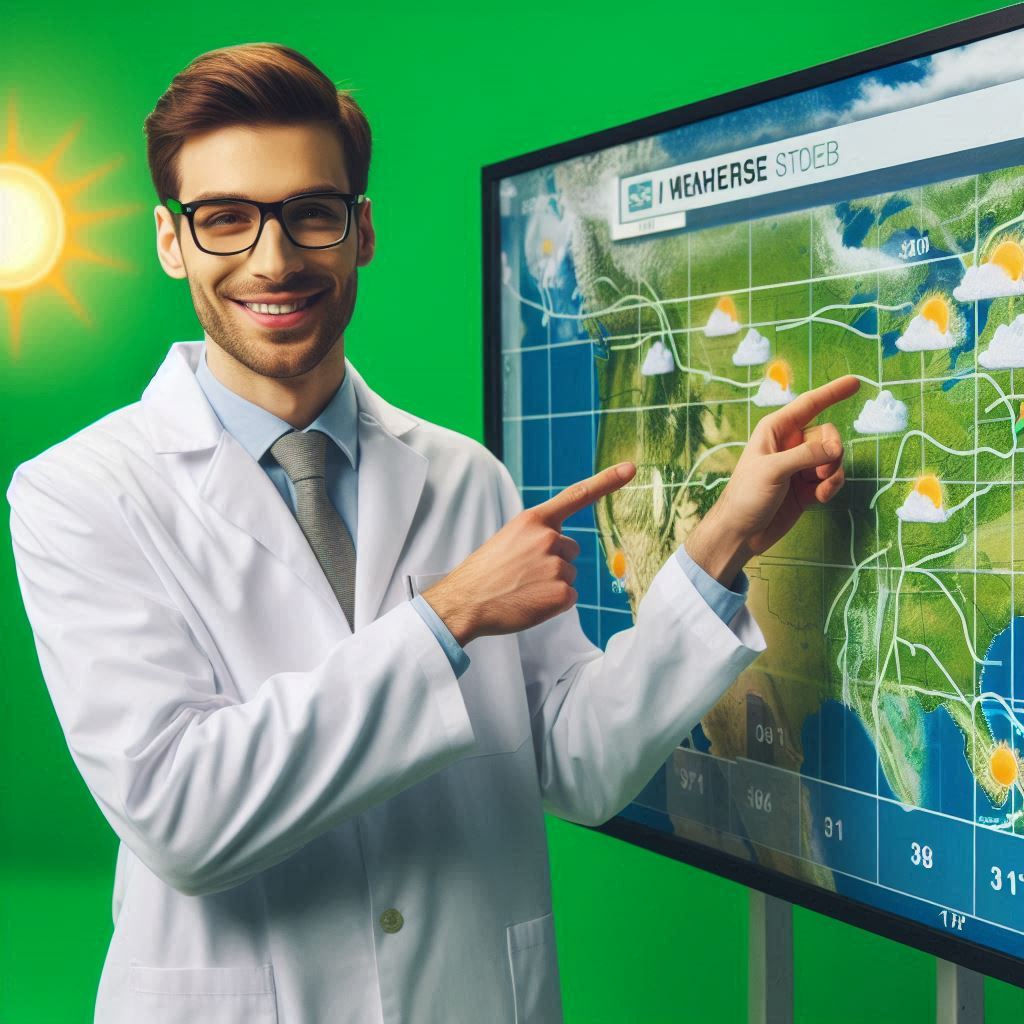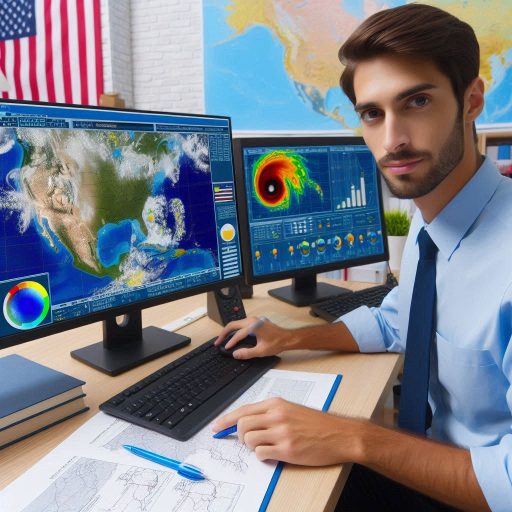Introduction
Meteorological models and data analysis are fundamental tools in the field of weather forecasting.
Meteorological models simulate atmospheric processes, allowing scientists to predict future weather patterns based on current conditions and historical data.
These models consider various factors, such as temperature, pressure, humidity, and wind patterns, to generate accurate forecasts.
Meanwhile, data analysis involves evaluating and interpreting vast amounts of meteorological data, helping forecasters understand complex weather systems.
Understanding these concepts is crucial for several reasons.
First, accurate weather forecasting impacts daily life, from planning outdoor activities to preparing for severe weather events.
Moreover, industries like agriculture, transportation, and disaster management rely on precise forecasts to make informed decisions.
By comprehending how meteorological models function and how data is analyzed, individuals can better appreciate the complexities involved in predicting weather.
This blog post will cover the essential elements of meteorological models, the significance of data analysis, and the interplay between the two in weather forecasting.
We will explore various modeling techniques, the importance of data accuracy, and how advancements in technology are shaping the future of meteorology.
Through this exploration, we aim to enhance your understanding of the vital role these concepts play in our daily lives.
Types of Meteorological Models
Meteorological models are essential for weather forecasting and climate studies.
They simulate the atmosphere‘s behavior and predict future conditions.
Various types of meteorological models exist, each serving different purposes.
Understanding these models helps meteorologists provide accurate forecasts.
Global Models
Global models cover vast areas, simulating weather patterns on a large scale.
These models typically use a grid system to represent the Earth.
They operate on a horizontal grid, with cells covering several kilometers.
Global models can predict weather patterns for days to weeks ahead.
Meteorologists often rely on them for long-range forecasting.
The Global Forecast System (GFS) is one popular example.
GFS provides detailed forecasts for the entire planet.
However, global models may lack local detail due to their coarse resolution.
Regional Models
Regional models focus on smaller areas, offering higher resolution forecasts.
They refine global model predictions by incorporating localized data.
These models often provide critical information for specific regions, such as cities or states.
Meteorologists use regional models for short-term forecasting, typically covering hours to a few days.
The Weather Research and Forecasting (WRF) model is a widely used regional model.
WRF allows for customization based on local geography and climate.
This flexibility enhances forecast accuracy for specific areas.
Mesoscale Models
Mesoscale models operate at an even finer scale, addressing weather phenomena occurring on a smaller scale.
These models capture processes such as thunderstorms, sea breezes, and terrain influences.
They provide valuable insights into localized weather events.
Mesoscale models typically cover areas from a few kilometers to several hundred kilometers.
They often run for short durations, focusing on rapid changes in the atmosphere.
Meteorologists use these models to predict severe weather events, such as tornadoes and heavy rainfall.
High-Resolution Rapid Refresh (HRRR) is a well-known mesoscale model.
Ensemble Models
Ensemble models combine multiple forecasts to improve prediction accuracy.
These models run several simulations using slightly varied initial conditions.
By analyzing the range of outcomes, meteorologists can assess uncertainty in forecasts.
Ensemble modeling helps identify the likelihood of various weather scenarios.
The European Centre for Medium-Range Weather Forecasts (ECMWF) uses ensemble forecasting to enhance predictions.
This approach enables meteorologists to provide more reliable and informed forecasts.
It also helps in understanding the potential impacts of severe weather events.
Understanding meteorological models is crucial for accurate weather forecasting.
Global, regional, mesoscale, and ensemble models each play significant roles.
By using these models effectively, meteorologists can provide timely and precise weather information.
This understanding helps communities prepare for and respond to changing weather conditions.
How Meteorological Models Work
Meteorological models are essential tools for predicting weather patterns and understanding atmospheric processes.
They rely on various input data sources, numerical methods, and output variables to produce forecasts.
Input Data Sources
Meteorological models begin with input data from numerous sources.
These sources include ground-based weather stations, satellites, and radar systems.
Ground-based stations measure temperature, humidity, wind speed, and precipitation.
Satellites provide valuable data on cloud cover and sea surface temperatures.
Radar systems track precipitation and storm systems in real time.
These diverse data sources offer a comprehensive view of the atmosphere.
Meteorologists collect this information to ensure models use the most accurate data available.
The integration of various datasets allows for a more precise understanding of weather systems.
Numerical Methods Used for Calculations
After gathering input data, meteorologists employ numerical methods to analyze the information.
These methods involve complex mathematical equations that represent physical laws governing atmospheric behavior.
Meteorological models typically use systems of differential equations to simulate atmospheric processes.
One widely used approach is the finite difference method.
This method divides the atmosphere into a grid, allowing for calculations at specific points.
Each grid point represents a small section of the atmosphere, enabling detailed simulations.
Another common numerical method is the spectral method.
This technique transforms physical variables into a series of waveforms.
These waveforms represent various atmospheric phenomena, allowing for more accurate modeling.
Meteorologists also utilize data assimilation techniques.
These techniques integrate new observational data into existing models.
This process improves the accuracy of forecasts by continuously updating model inputs.
Output Variables and Parameters
Once meteorological models perform calculations, they generate output variables and parameters.
These outputs include temperature, precipitation, wind speed, and atmospheric pressure.
Models also produce visualizations, such as maps and graphs, to represent forecasted weather patterns.
Meteorologists analyze these outputs to provide forecasts and warnings.
They interpret the data to understand potential weather events, such as storms or heatwaves.
This analysis helps communities prepare for various weather conditions.
In summary, meteorological models are vital for understanding and predicting weather.
They rely on input data from multiple sources, utilize advanced numerical methods for calculations, and generate crucial output variables.
By comprehensively analyzing these elements, meteorologists can provide accurate and timely weather forecasts.
Understanding how these models work empowers individuals and organizations to make informed decisions in response to changing weather conditions.
Read: What Does a Geologist Do? Career Overview and Insights
Sources of Meteorological Data
Meteorological models depend on various data sources to create accurate weather forecasts.
These sources include ground-based observations, satellite data, radar data, weather balloons, and remote sensing techniques.
Each source contributes unique information about the atmosphere and its conditions.
Ground-Based Observations
Ground-based observations are crucial for collecting real-time weather data.
Weather stations, often located at airports, research centers, and universities, provide essential measurements.
These stations monitor temperature, humidity, wind speed, and precipitation.
They also record atmospheric pressure and visibility.
Ground-based observations offer a detailed view of localized weather conditions, making them vital for short-term forecasts.
Satellite Data
Satellites play a significant role in meteorological data collection.
They orbit the Earth and capture images and measurements of the atmosphere.
Satellite data provides information about cloud cover, sea surface temperatures, and large-scale weather patterns.
Different satellites use various sensors to gather data across different wavelengths, allowing for comprehensive atmospheric monitoring.
This data is essential for tracking storm systems and understanding climate trends.
Radar Data
Radar systems are instrumental in observing precipitation and storm development.
Weather radar uses microwave signals to detect raindrops and other precipitation particles in the atmosphere.
This technology allows meteorologists to track the intensity, movement, and structure of storms.
Radar data is crucial for issuing timely warnings for severe weather events like thunderstorms, tornadoes, and flash floods.
Weather Balloons
Weather balloons, or radiosondes, are essential for collecting upper-atmosphere data.
These balloons carry instruments that measure temperature, humidity, pressure, and wind speed at various altitudes.
As the balloon ascends, it transmits data back to meteorologists on the ground.
This information is vital for understanding vertical atmospheric profiles and forecasting weather changes.
Weather balloons are typically released twice a day from numerous locations worldwide.
Remote Sensing Techniques
Remote sensing techniques involve collecting data from a distance using various technologies.
These techniques include using aircraft, drones, and ground-based sensors to monitor weather conditions.
Remote sensing provides valuable information about land surface temperatures, vegetation cover, and soil moisture.
It enhances our understanding of how local and regional conditions impact weather patterns.
Accurate meteorological forecasts rely on diverse data sources.
Ground-based observations provide localized data, while satellites and radar offer broader insights.
Weather balloons gather vital upper-atmosphere information, and remote sensing techniques contribute additional context.
By integrating these data sources, meteorologists can create more precise weather models and improve forecasts.
Understanding these sources helps us appreciate the complexity of meteorology and its impact on our daily lives.
Read: Educational Path: Becoming a Geologist in the USA

Data Analysis Techniques in Meteorology
Meteorological models require robust data analysis techniques to interpret the vast amount of information they collect.
These techniques include data assimilation methods, statistical analysis, visualization tools, and validation and verification processes.
Together, they enhance the accuracy and reliability of weather forecasts.
Data Assimilation Methods
Data assimilation is a crucial technique used in meteorology to integrate real-time observational data into numerical models.
This process improves the accuracy of forecasts by adjusting model inputs based on new data.
Meteorologists use various data assimilation techniques, such as the Kalman filter and variational methods.
The Kalman filter continuously updates model states using incoming data, while variational methods minimize the difference between observed and model-predicted states.
Both methods ensure that models remain aligned with the most current atmospheric conditions.
Transform Your Career Today
Unlock a personalized career strategy that drives real results. Get tailored advice and a roadmap designed just for you.
Start NowStatistical Analysis
Statistical analysis plays a significant role in meteorology, helping researchers interpret weather data.
This analysis involves applying statistical techniques to identify patterns, correlations, and trends within datasets.
Meteorologists use regression analysis, time series analysis, and correlation coefficients to understand relationships between variables, such as temperature and precipitation.
These statistical tools help forecasters recognize potential weather events based on historical data and improve long-term climate predictions.
Visualization Tools
Visualization tools are essential for interpreting and communicating complex meteorological data.
Meteorologists utilize various graphical representations, including maps, charts, and 3D models.
These visualizations help convey critical information about weather patterns, storm tracks, and climate trends.
Geographic Information Systems (GIS) are commonly used to create detailed maps that display spatial relationships and meteorological phenomena.
Effective visualization aids meteorologists in making informed decisions and communicating findings to the public.
Validation and Verification Processes
First, Validation and verification processes ensure the accuracy of meteorological models and forecasts.
Validation involves comparing model outputs with independent observational data to assess performance.
Meteorologists use metrics such as root mean square error (RMSE) and mean absolute error (MAE) to quantify model accuracy.
Verification, on the other hand, assesses the reliability of forecasts by comparing them to actual weather outcomes.
This process identifies biases in forecasting models and highlights areas for improvement.
Data analysis techniques are vital for interpreting meteorological data and improving weather forecasts.
Data assimilation methods enhance model accuracy by integrating real-time observations.
Statistical analysis identifies patterns and trends within weather data.
Visualization tools effectively communicate complex information, while validation and verification processes ensure model reliability.
Together, these techniques empower meteorologists to make informed predictions and enhance our understanding of atmospheric processes.
By mastering these data analysis techniques, meteorologists can provide accurate and timely weather information that impacts daily life.
Read: Botany Career Fairs and Networking Events
Challenges in Meteorological Modeling and Data Analysis
Meteorological modeling and data analysis are essential for accurate weather forecasting.
However, several challenges hinder the effectiveness of these processes.
Key challenges include uncertainties in input data, model biases and errors, complex interactions in the atmosphere, and limited computing resources.
Uncertainties in Input Data
One significant challenge in meteorological modeling is the uncertainty in input data.
Weather observations can vary due to differences in measurement techniques and equipment.
Ground-based weather stations may not capture conditions in remote or sparsely populated areas.
Satellite data can also be affected by cloud cover or atmospheric interference, leading to inaccuracies.
These uncertainties can propagate through the modeling process, resulting in less reliable forecasts.
Meteorologists continuously work to improve data collection methods and address these uncertainties.
Model Biases and Errors
Model biases and errors pose another challenge in meteorological modeling.
These biases occur when a model consistently overestimates or underestimates specific weather variables.
Errors can arise from several factors, including simplifications in the model equations or inaccuracies in parameterization.
For example, representing physical processes like cloud formation or precipitation can introduce errors in predictions.
Understanding and mitigating these biases is critical for improving model performance.
Researchers regularly evaluate and adjust models to reduce these biases and enhance forecast accuracy.
Complex Interactions in the Atmosphere
The atmosphere is a highly complex system with numerous interacting components.
These interactions include the exchange of heat, moisture, and momentum between the land, ocean, and atmosphere.
Additionally, small-scale phenomena, such as localized thunderstorms, can significantly impact larger weather patterns.
Capturing these complex interactions in meteorological models is challenging.
Simplifications often lead to inaccuracies in forecasting.
Scientists continue to refine models to better represent these interactions and improve predictive capabilities.
Limited Computing Resources
Limited computing resources present a significant hurdle in meteorological modeling and data analysis.
Accurate weather forecasting requires extensive computations, especially for high-resolution models.
As models become more sophisticated, they demand increased processing power and memory.
Many meteorological agencies face constraints in their computing infrastructure, which can limit the resolution and scope of their forecasts.
To address this challenge, researchers explore advanced computing techniques, such as parallel processing and cloud computing, to enhance model performance and efficiency.
Meteorological modeling and data analysis face various challenges that impact forecast accuracy.
Uncertainties in input data can arise from measurement variations, while model biases and errors can result from simplifications and parameterization issues.
The complex interactions within the atmosphere further complicate modeling efforts.
Additionally, limited computing resources constrain the ability to run high-resolution models.
Addressing these challenges is vital for improving weather forecasting and advancing our understanding of atmospheric processes.
By continuously refining models and enhancing data collection techniques, meteorologists can overcome these obstacles and provide more reliable weather predictions.
Read: Preparing for a Botany PhD: Tips and Advice
Learn More: Career Growth and Advancement Opportunities in Pharmacology
Applications of Meteorological Models and Data Analysis
Meteorological models and data analysis play a crucial role in various fields.
Their applications range from everyday weather forecasting to significant climate research.
Key areas where these models are used include weather forecasting, climate research, environmental monitoring, aviation and transportation, and disaster preparedness.
Weather Forecasting
One of the most well-known applications of meteorological models is weather forecasting.
Meteorologists use numerical models to predict short-term weather conditions, such as temperature, precipitation, and wind speed.
By analyzing current atmospheric data and employing sophisticated algorithms, they generate forecasts that inform the public and decision-makers.
Accurate weather forecasts help individuals plan their daily activities and enable industries to prepare for changing weather conditions.
Climate Research
Meteorological models are essential in climate research, helping scientists understand long-term weather patterns and trends.
Researchers utilize these models to simulate various climate scenarios, allowing them to assess potential impacts of climate change.
By analyzing historical data and projecting future conditions, scientists can evaluate how changes in temperature and precipitation affect ecosystems, agriculture, and human health.
This research is vital for developing effective climate adaptation and mitigation strategies.
Environmental Monitoring
Environmental monitoring benefits significantly from meteorological data analysis.
By tracking weather conditions, researchers can assess air quality, pollution levels, and ecosystem health.
Meteorological models help identify sources of pollution and monitor how weather patterns influence air quality.
This information is crucial for public health initiatives and regulatory agencies focused on environmental protection.
Additionally, understanding weather impacts on ecosystems aids in wildlife conservation and habitat management.
Aviation and Transportation
In aviation and transportation, meteorological models provide critical information for safe operations.
Airlines rely on accurate weather forecasts to optimize flight routes and schedules.
Meteorological data helps predict turbulence, thunderstorms, and other hazardous conditions that could impact flight safety.
Furthermore, transportation agencies use weather models to manage road conditions, ensuring the safety of drivers during adverse weather events.
By integrating meteorological data into transportation systems, authorities can improve efficiency and safety.
Disaster Preparedness
Meteorological models are vital for disaster preparedness and response.
Accurate weather forecasts help communities prepare for extreme weather events, such as hurricanes, floods, and heatwaves.
Emergency management agencies rely on these forecasts to issue timely warnings and mobilize resources effectively.
By understanding potential impacts and vulnerabilities, communities can develop mitigation strategies to reduce disaster risks.
In this way, meteorological models enhance resilience and improve public safety during emergencies.
In essence, the applications of meteorological models and data analysis are vast and impactful.
From daily weather forecasting to climate research, environmental monitoring, aviation, and disaster preparedness, these models play a vital role in our understanding of the atmosphere.
By leveraging advanced modeling techniques and data analysis, we can better predict and respond to weather-related challenges.
As technology continues to advance, the accuracy and reliability of meteorological models will further improve, benefiting society as a whole.
Conclusion
Understanding meteorological models and data analysis is essential for accurate weather forecasting.
We discussed how these models simulate atmospheric conditions and predict future weather events.
Each model employs complex algorithms and historical data to generate forecasts.
Accurate data analysis enhances our comprehension of intricate weather patterns and their implications.
The relevance of meteorology extends far beyond daily weather updates.
It plays a crucial role in climate change assessments, agriculture planning, and disaster management.
For instance, farmers rely on precise forecasts to optimize planting and harvesting schedules.
Similarly, emergency services depend on timely weather data to prepare for natural disasters.
Exploring this topic further can deepen your insights into the dynamics of weather phenomena.
Continuous learning is vital for improving forecasting techniques and adapting to evolving challenges in meteorology.
Engaging with new research, technology, and methods will enhance your understanding of this ever-evolving field.
By remaining curious, we can better prepare for the impacts of weather on our daily lives.
Embrace the journey of learning and stay informed about developments in meteorological science.
Each step toward knowledge fosters innovation and improves our predictive capabilities.
Together, we can advance our understanding and response to the ever-changing atmosphere.
As we continue to explore the fascinating world of meteorology, we contribute to a safer and more informed society.




